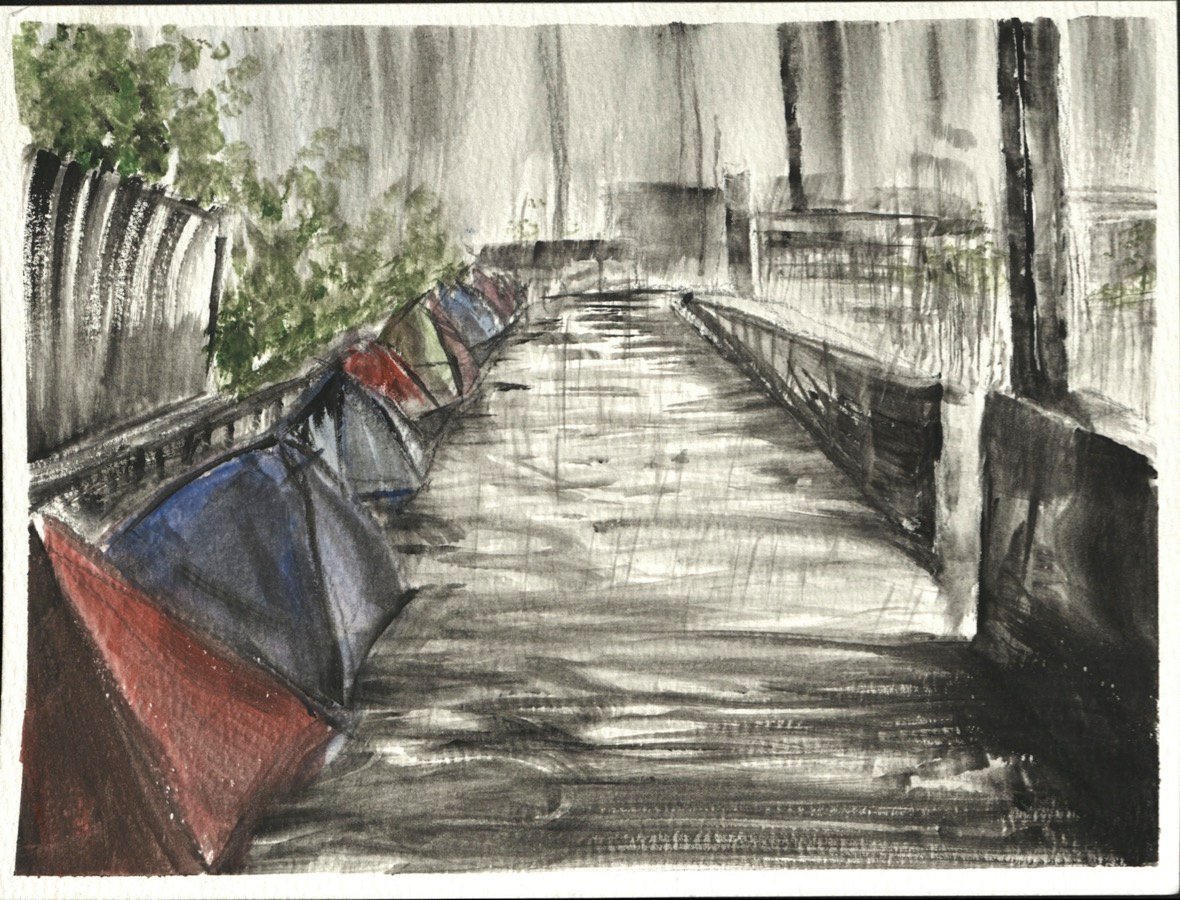Pyramid Power
Pyramid Power
BY MARCELA SULAK The Pyramids of Malpighi By Steve Gehrke Anhinga Press 80 pages, $12  native of Minnesota, Steve Gehrke lived in Austin from 1999-2002, during which time, as a James Michener Fellow at the University of Texas, he wrote most of the poems that comprise The Pyramids of Malpighi. The year he arrived, his first book, The Resurrection Machine, had just been chosen for a major poetry prize. It was published in 2000 by BkMk Press. The year he graduated, The Pyramids of Malpighi was selected for another major poetry award and was recently published by Anhinga Press. For a young poet these are remarkable accomplishments. Both of Steve Gehrke’s books draw upon his experiences of kidney failure, dialysis, illness and recovery, rendered in such precise and detailed descriptions that they seem more universal than personal. Both collections are populated by the author’s family members, favorite painters and other heroes, and are comprised of autobiographical anecdotes. But he presents the material in such a way as to make it seem as if those family members, personal heroes and personal anecdotes could be a part of anyone’s life. If Gehrke’s first book chronicled the body, its miraculous life, and its impending death, his second book describes what the mind does with and through the body, and the ideas that perpetuate it. The Resurrection Machine is held together by a faith in the body’s inscrutable mechanisms, but The Pyramids of Malpighi succeeds through its faith in the connectedness of the world: “If there is an afterlife, it is in the imagination of others,” he writes in one poem, positing a tremendous faith in the imagination and its playground, the world. Steve Gehrke’s poems are important because they teach us not just that the things in our lives have meaning, but also how things have meaning. In “The Invention of Pointillism,” the poem that opens the collection, Gehrke writes that we have
native of Minnesota, Steve Gehrke lived in Austin from 1999-2002, during which time, as a James Michener Fellow at the University of Texas, he wrote most of the poems that comprise The Pyramids of Malpighi. The year he arrived, his first book, The Resurrection Machine, had just been chosen for a major poetry prize. It was published in 2000 by BkMk Press. The year he graduated, The Pyramids of Malpighi was selected for another major poetry award and was recently published by Anhinga Press. For a young poet these are remarkable accomplishments. Both of Steve Gehrke’s books draw upon his experiences of kidney failure, dialysis, illness and recovery, rendered in such precise and detailed descriptions that they seem more universal than personal. Both collections are populated by the author’s family members, favorite painters and other heroes, and are comprised of autobiographical anecdotes. But he presents the material in such a way as to make it seem as if those family members, personal heroes and personal anecdotes could be a part of anyone’s life. If Gehrke’s first book chronicled the body, its miraculous life, and its impending death, his second book describes what the mind does with and through the body, and the ideas that perpetuate it. The Resurrection Machine is held together by a faith in the body’s inscrutable mechanisms, but The Pyramids of Malpighi succeeds through its faith in the connectedness of the world: “If there is an afterlife, it is in the imagination of others,” he writes in one poem, positing a tremendous faith in the imagination and its playground, the world. Steve Gehrke’s poems are important because they teach us not just that the things in our lives have meaning, but also how things have meaning. In “The Invention of Pointillism,” the poem that opens the collection, Gehrke writes that we have
only two choices. We can believe, stubbornly, that the picture on the wall is whole. Or we can imagine Seurat, as a boy, holding a fresh brush in his hand, thinking, “I will show them how easily they are tricked,” then narrowing the tip with his mouth.
This is an apt and beautiful way to open a collection that chronicles the tension between the individual and the whole, belief and skepticism, yearning and abundance, in the context of everyday life. There are no easy answers here, no synthesis of dichotomies. The consolation offered by the collection is a belief in the will to believe. As the narrator of “Pointillism” observes, describing a husband who has been deceived by his wife and complicit children:
But if, some mornings, he sits with the paper, pretending to read, but really watching his family orbit through the V of light as he turns the pages, as he believes, stubbornly, in their goodness, what could be wrong with that?
One of the many strengths of Gehrke’s work is that the narrator lays out the options and, like a good doctor, explains his choices, so that the reader becomes an accomplice in the transforming work of art. The title of the first poem, “The Invention of Pointillism,” describes Gerhke’s technique. Pointillism is a method of painting in which the artist uses dots, or points, that blend together into shapes and forms when viewed from a distance. Gehrke describes each object in each poem so vividly and completely that the reader is quite content to believe that “the only truth is the truth within a single cell.” Yet the stories within the poems—and between them—provide a compelling reason to believe in the shapes and forms that emerge when viewed from a distance. In The Pyramids of Malpighi, everything becomes a pointillist dot: that which, having no dimensions, no length or width, also has no limits—blood cells coursing through a dialysis machine, an ice house on a frozen lake, a snow flake. Just as with the individual points in pointillism, the images in these poems, often small and round objects, give heft and meaning to everything around them. For example, the milk cap swallowed by a small child in “Manhole Covers and Lakes” recovers the two titular objects, after the narrator decides, “There isn’t much to do with a love for manhole covers and lakes.” Nothing except to feel “the future seal together inside me, as it only can when what happens is so precisely what we hadn’t known we’d planned.” Gehrke earns our trust by showing us his hand before each trick, even explaining how the trick works:
Berlin: 1913: and Kirchner’s at his window, looking playfully down the sight-line of a brush, preparing to paint the error in ?— (from “After Ernst Kirchner’s Berlin Street Scene”)
The trick is the beautiful, necessary flaw around which the words, images, and ideas gather. Much homage is paid here to many kinds of flaws from which the poems take their sustenance: marital infidelity, a useless kidney, a defective donor kidney, a failing memory, a gambling addiction, Ginger Roger’s bloody feet, a misdirected bullet. It is impossible to achieve Kirchner’s wish “to do away / with the exterior and look straight down / into the pain,” but this impossibility is what makes art possible. Like Kirchner’s paintings, Gehrke’s poems only appear to “put an end to possibility” by providing an interpretive frame for the flaws of life whose existence calls for interpretation, but this kind of end to possibility is simply another “deception” added “to the scene.”  t is daring, of course, to expose one’s methods so clearly that this exposure and vulnerability become part of the poem. It is even more daring to traffic in truth. One might say that the flaws in every object, in every life, demonstrate the book’s epigraph by A. R. Ammons: “You cannot come to unity and remain material.” Gehrke’s most frequently recurring flaw, the one through which the narrator most often comes to unity, is the one in the title poem—the flaw hidden in the kidney donated by the narrator’s mother. The poem opens with an image of the flaw as
t is daring, of course, to expose one’s methods so clearly that this exposure and vulnerability become part of the poem. It is even more daring to traffic in truth. One might say that the flaws in every object, in every life, demonstrate the book’s epigraph by A. R. Ammons: “You cannot come to unity and remain material.” Gehrke’s most frequently recurring flaw, the one through which the narrator most often comes to unity, is the one in the title poem—the flaw hidden in the kidney donated by the narrator’s mother. The poem opens with an image of the flaw as
something twisted, something clogged- tiny, impossible to detect even for the surgeon who lowers it into me, carefully, as if he’s holding a nest, as if it could unravel in his hands.
The subsequent 12 sections of the poem detail the unraveling of the flaw through an intricate crosshatching of death and resurrection. In the next scene a snow-bound trio is forced to eat the body of a companion to stay alive. The invisible flaw of the kidney has now become an opening in the dissected body around which the companions gather, “as if around a fire, as if what’s inside / could warm their hands.” “Did you think,” the narrator asks his mother a few sections later, “I was your slick passage out of death?” In a later passage Gehrke introduces an ancient body uncovered during an archeological dig in a desert. Unlike the kidney, the bones “will not speak or clot.” The poem ends with a recovery of sorts: the trio lost in snow is recovered, and in the body that receives the kidney, —the fabric weaves together to build an opening, the room breaks into walls, the boy’s cells arrange his face, the kidney drawn into the orbit of its flaw. And the music, insistent, as if it could seal these openings, these pores. . . To the last poem in the collection, “Inside the Dialysis Machine,” The Pyramids of Malpighi is a meditation about how the truths of single cells must come apart before they can come to unity. The poems yearn toward the healing power hidden in pain, loss, and flaws, revealing the connection between the hole and the whole. Anything can be a healing agent: the ubiquitous Minnesota snow that annually transmits the secret dreams from one generation to the next, the shingles a grandfather pounds in place, a secretarial class where a single mother studies, and the cream cheese folded inside a wonton wrapper in a Chinese diner. Even capitalism: “The point, you suppose, / is that our bodies are lost and given back to us in change.” These poems are urgent, and they feel true and right. The tension between the individual and the whole, the abstract and the earthy, then, is incarnate in the choice between believing in the whole, and believing that Seurat is tricking us, that things have no meaning outside themselves after all. These poems help us see that our flaws are what allows us to connect to others. As Gehrke puts it in “The Green Bridge”
broken, we already are the scattering, not of ashes, but of the visible called back.
Despite their deeply profound insights, these narrative poems are pleasurable, even delightful, to read. It takes an intelligent and generous talent to reward the reader so much for just a little faith. Marcela Sulak is a poet and translator who lives in Austin. She is currently working on a dissertation at the University of Texas about poets in New York between the wars.


